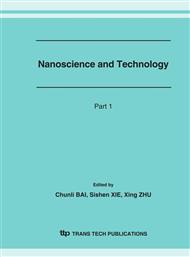p.1077
p.1081
p.1085
p.1089
p.1093
p.1097
p.1103
p.1109
p.1115
Experimental and Numerical Studies on B-DNA Overstretching Transition in Presence of Sodium Ions at Physiological Temperature
Abstract:
In this paper, the effects of Na+ concentration on the overstretching transition of B-DNA molecule at physiological temperature are studied by both experimental and numerical methods. Using optical tweezers, the relationship of external force and relative extension is obtained by stretching single B-DNA molecule at 37°C. As the concentration increases from 0.909mM to 909mM, the overstretching transition force increases from 65.65 ± 1.2pN to 43.07 ± 1.2pN. An analytical expression is derived, which shows that overstretching transition force is linear with the natural logarithm of salt concentration. Based on a previous model, a three-dimensional model is proposed herein and solved by Metropolis Monte Carlo method. The bending deformation of DNA backbones, cooperativity of base-stacking interactions, electrostatic interactions, and spatial effects of DNA double helix structure are taken into account. Our key contribution is that the electrostatic energy is explicitly given as a function of folding angle and Na+ concentration. A new parameter is also introduced to account for the cooperativity of base-stacking interactions. The numerical results of this model are in good agreement with our experimental results.
Info:
Periodical:
Pages:
1093-1096
Citation:
Online since:
March 2007
Authors:
Price:
Сopyright:
© 2007 Trans Tech Publications Ltd. All Rights Reserved
Share:
Citation:


